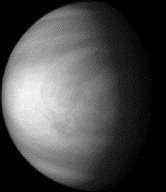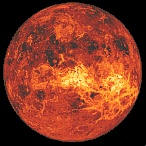
Venus

Venus is the second planet from the Sun. Its orbit is said to be inferior as it lies between the Sun and the Earth, and, as a consequence, it always appears in the sky comparatively near to the Sun, being visible a little before sunrise or a little after sunset.
The planet's atmosphere is composed mainly of carbon dioxide, (CO2) amounting to 97% of the total mass. As a result of the carbon dioxide's greenhouse effect, the surface temperature is as high as 490 degC, slightly hotter than Mercury!
Curious Rotation The planet rotates from east to west once every 243 Earth days, in stark contrast to all other planets. Yet its orbit takes only 225 days. The upper clouds have been observed to rotate once every four days indicating winds of 100m/s. These clouds extend to 70km above the planet's surface, and obscure all of the surface details from telescopes on Earth. They are largely composed of sulphuric acid (H2SO4), and make conditions at the surface highly corrosive.
Probes to Venus The Russians launched a number of Venera series probes to send back information from Venus, Venera 1 being launched in 1961. However, most of the early probes failed for various reasons, not in the least because of the hostile conditions found on the planet's surface.

It wasn't until 1975 that the first pictures were returned by Veneras 9 and 10. In 1985, the Soviet Vega probes visited both Venus and Halley's Comet. More information.
On August 10th, 1990, the NASA Magellan probe entered orbit - the first probe ever to become an artificial satellite of another planet. It was named after the sixteenth-century Portuguese explorer who was the first to circumnavigate the earth. The surface of Venus is normally completely shrouded by the dense clouds. However, by using RADAR, Magellan was able to complete a very successful mission in October, 1994, having mapped 98% of its surface in highly intricate detail. The image below is from a mosaic of RADAR images, with a resolution 10ã better than the earlier Soviet Venera missions.

The RADAR used, operated at a frequency of 2 deg385 GHz, peak power of 325W, and pulse length of 26.5 microsec. During its extended mission, completed in September 1992, two further mapping cycles brought coverage to 98%, showing detail of about 100m. Magellan allowed the first global geological understanding of Venus, the planet most like Earth in the Solar System.
Venus in Transit About once or twice a century, Venus passes directly in front of the Sun, as viewed from the Earth (much like the Moon does during a Solar Eclipse). This last happened in 1874 and 1882, but will next occur in 2004 and 2012. The great Edmund Halley never saw a transit, but recognised their importance in measuring the size of the solar system. Through his work, explorers including Captain Cook were to make observations of transits in 1761 and 1769, after Halley & Rsquos death.